We commend Amelia’s owners for their vigilance and quick action, which almost certainly saved her life.
Preventing a tick
Like Amelia’s owners, we recommend all pet owners perform daily tick checks on their pets.
You can do this by running your fingertips through your pet’s coat and checking the whole skin surface for bumps. Be extra attentive when checking around the head, mouth, neck, chest and shoulders.
Preventative tick treatments are also essential and your regular vet can advise you on the best option for your pet.
We recommend you be vigilant if your pet wanders into long grass, undergrowth, under trees or if you have native wildlife close to your home.
Emergency first aid for a pet with a tick
If you find a tick on your pet it is important to remove it immediately.
We recommend using a pair of pointed tweezers. Part your pet’s hair and then place the tweezers as close as you can to the skin on either side of the tick. Gently pull the tick away from the skin until it releases. Be careful not to twist the tweezers or squash the tick as this can worsen toxicity.
If your pet is showing signs of tick paralysis it’s important to seek urgent medical assistance. Additionally:
- don’t give any food or water by mouth
- keep your pet cool and as calm as possible on the trip to the vet
- take the removed tick with you so that it can be identified.
Early detection and treatment is critical in tick paralysis cases. If you suspect your pet has been affected, contact your local vet or an after hours an emergency vet hospital.
.png)











